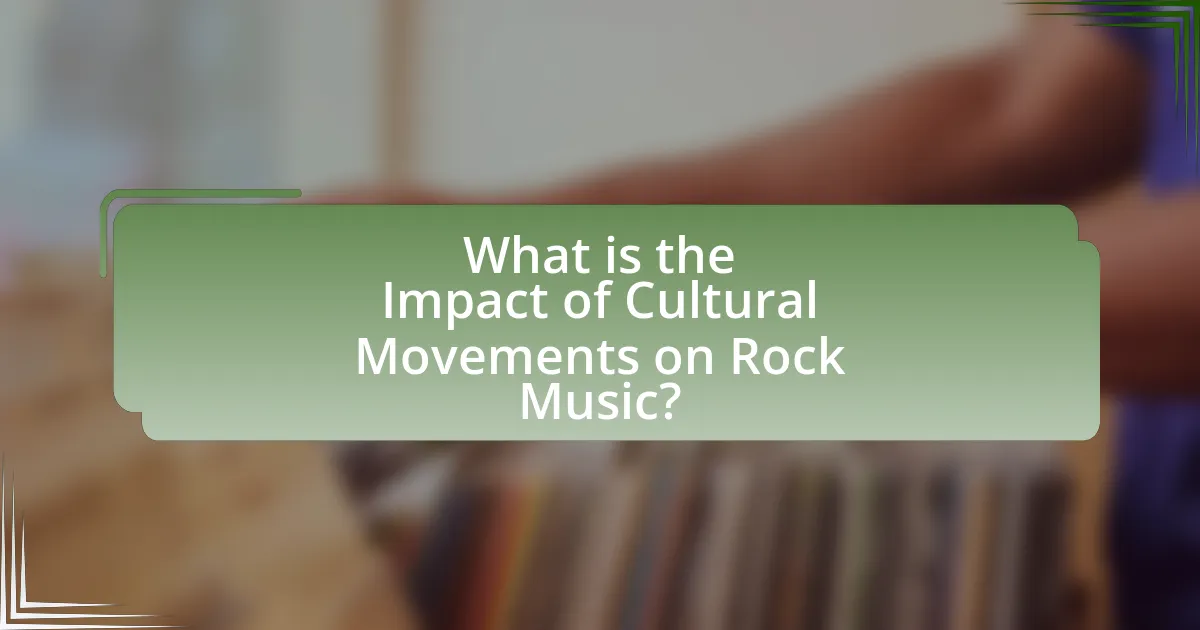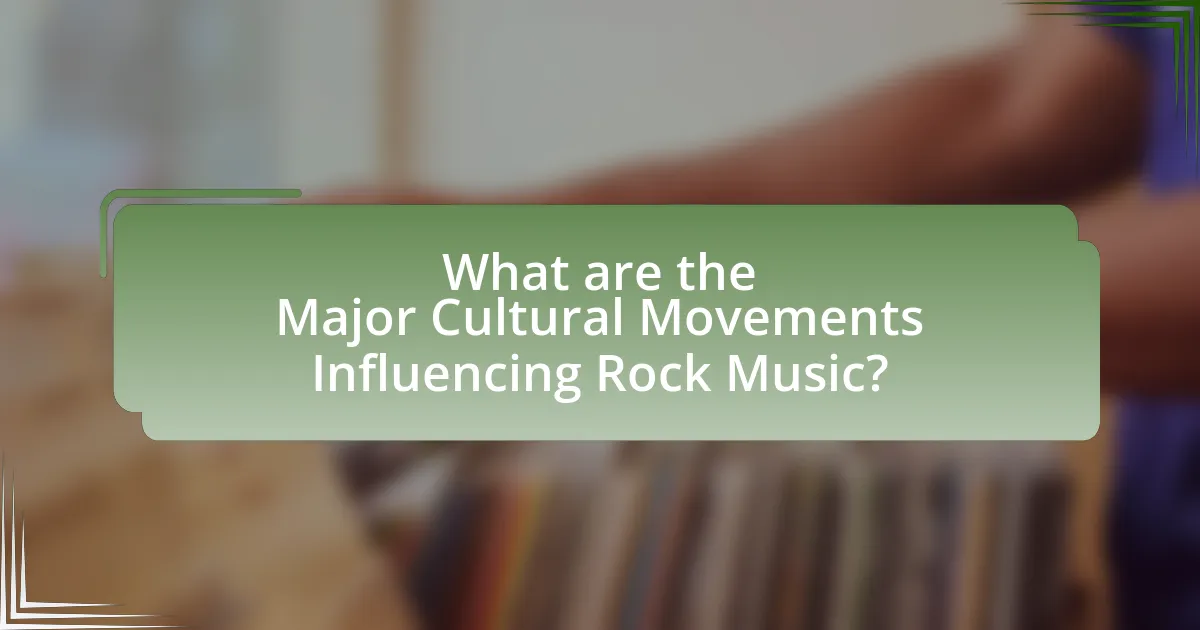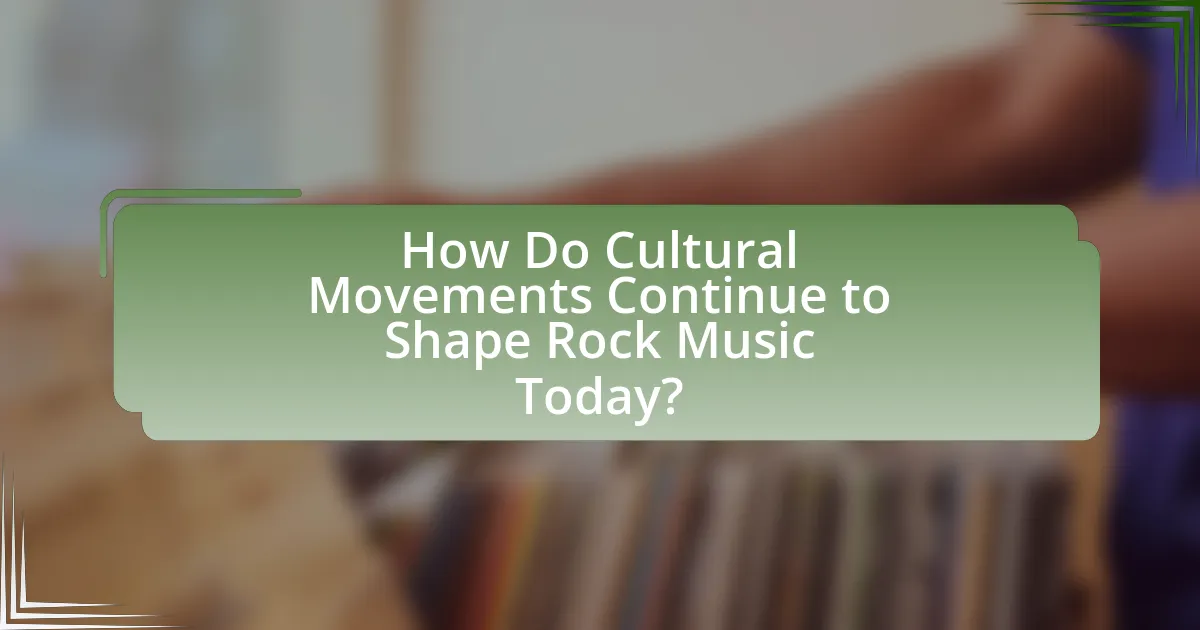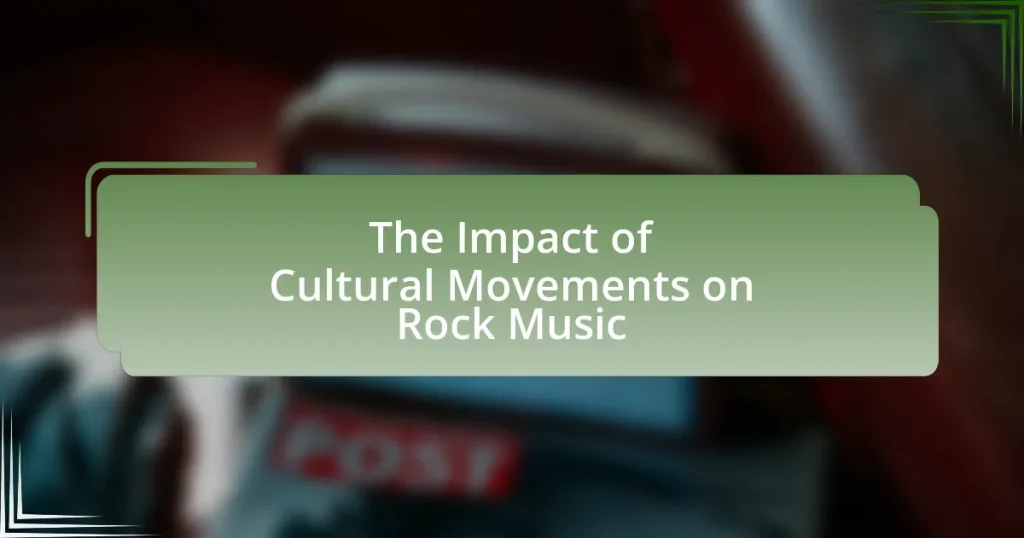The article examines the impact of cultural movements on rock music, highlighting how various social and political shifts have influenced the genre’s themes, styles, and messages. Key cultural movements discussed include the civil rights movement, the counterculture of the 1960s, and the punk movement of the 1970s, each contributing to the evolution of rock music as a platform for social commentary and change. The article also explores how contemporary cultural movements continue to shape modern rock, reflecting ongoing societal issues such as social justice and environmental activism. Additionally, it emphasizes the importance of understanding these cultural contexts to enhance appreciation of rock music and its historical significance.

What is the Impact of Cultural Movements on Rock Music?
Cultural movements significantly shape rock music by influencing its themes, styles, and social messages. For instance, the counterculture movement of the 1960s introduced anti-establishment sentiments and experimentation in sound, leading to iconic albums like “Sgt. Pepper’s Lonely Hearts Club Band” by The Beatles, which reflected the era’s social upheaval. Additionally, the feminist movement in the 1970s brought attention to women’s rights, inspiring artists like Joan Jett and Patti Smith to challenge gender norms within the genre. The punk movement of the late 1970s further transformed rock music by promoting DIY ethics and raw sound, exemplified by bands like The Ramones and Sex Pistols, who rejected mainstream conventions. These cultural movements not only influenced the musical landscape but also provided a platform for social commentary, making rock music a vehicle for cultural expression and change.
How have cultural movements historically influenced rock music?
Cultural movements have historically influenced rock music by shaping its themes, styles, and social messages. For instance, the civil rights movement in the 1960s inspired artists like Bob Dylan and Jimi Hendrix to address social justice and equality in their lyrics, reflecting the era’s struggles and aspirations. Additionally, the counterculture movement, characterized by anti-establishment sentiments, led to the emergence of psychedelic rock, with bands like The Doors and Jefferson Airplane incorporating experimental sounds and lyrics that challenged societal norms. The punk movement in the 1970s further transformed rock music by promoting raw, unpolished sounds and a DIY ethic, as seen in the works of The Ramones and Sex Pistols, which directly responded to political disillusionment and economic hardship. These examples illustrate how cultural movements have not only influenced the sound of rock music but also its role as a vehicle for social commentary and change.
What are the key cultural movements that shaped rock music?
The key cultural movements that shaped rock music include the Civil Rights Movement, the counterculture of the 1960s, and the punk movement of the 1970s. The Civil Rights Movement influenced rock music by promoting themes of social justice and equality, which were reflected in songs by artists like Bob Dylan and Sam Cooke. The counterculture of the 1960s, characterized by anti-establishment sentiments and the embrace of alternative lifestyles, led to the emergence of psychedelic rock and the festival culture, exemplified by events like Woodstock in 1969. The punk movement of the 1970s reacted against the perceived excesses of mainstream rock, emphasizing raw energy and DIY ethics, as seen in bands like The Ramones and Sex Pistols. Each of these movements contributed to the evolution of rock music by introducing new ideas, styles, and social commentary.
How did the social and political climate affect rock music evolution?
The social and political climate significantly influenced the evolution of rock music by shaping its themes, styles, and the artists’ messages. For instance, during the 1960s, the civil rights movement and anti-war protests inspired rock musicians to address social justice and political dissent in their lyrics, as seen in songs like “Fortunate Son” by Creedence Clearwater Revival, which criticized the Vietnam War. Additionally, the counterculture movement fostered a spirit of rebellion and experimentation, leading to the emergence of diverse subgenres such as psychedelic rock and punk rock, which often reflected societal upheaval and youth disillusionment. The Watergate scandal and subsequent political disillusionment in the 1970s further propelled rock music into more introspective and critical narratives, exemplified by artists like Bob Dylan and Bruce Springsteen, who articulated the struggles of the American working class. Thus, the interplay between social movements and political events has been a driving force in the thematic and stylistic evolution of rock music.
Why is understanding cultural movements important for rock music?
Understanding cultural movements is crucial for rock music because they shape the genre’s themes, styles, and social messages. Rock music has historically emerged as a response to cultural shifts, such as the counterculture of the 1960s, which influenced the music’s rebellious spirit and lyrical content. For instance, the civil rights movement and anti-war protests inspired artists like Bob Dylan and Joan Baez, leading to songs that addressed social justice and political issues. This connection between cultural movements and rock music not only reflects societal values but also drives the evolution of the genre, making it a powerful medium for expression and change.
How do cultural movements reflect societal changes in rock music?
Cultural movements reflect societal changes in rock music by influencing its themes, styles, and messages. For instance, the counterculture movement of the 1960s, characterized by anti-establishment sentiments and a push for civil rights, led to the emergence of rock music that addressed social issues, such as protest songs by artists like Bob Dylan and bands like Creedence Clearwater Revival. This shift in lyrical content mirrored the societal demand for change and the questioning of authority during that era. Additionally, the punk rock movement of the 1970s, which arose in response to political disillusionment and economic hardship, showcased a raw, aggressive sound and a DIY ethic that reflected the frustrations of youth at the time. These examples demonstrate how rock music serves as a barometer for societal attitudes and changes, with each cultural movement leaving a distinct mark on the genre’s evolution.
What role does rock music play in cultural movements?
Rock music serves as a catalyst for cultural movements by providing a voice for social change and challenging the status quo. Throughout history, rock music has been intertwined with significant cultural shifts, such as the civil rights movement in the 1960s, where artists like Bob Dylan and Jimi Hendrix used their music to address issues of inequality and injustice. Additionally, the anti-war movement was amplified by rock anthems like “Fortunate Son” by Creedence Clearwater Revival, which criticized the Vietnam War and resonated with a generation seeking peace. The genre’s rebellious spirit has consistently inspired youth culture, fostering a sense of identity and community among listeners. Rock music’s ability to reflect and influence societal values underscores its pivotal role in shaping cultural movements.

What are the Major Cultural Movements Influencing Rock Music?
The major cultural movements influencing rock music include the counterculture of the 1960s, the civil rights movement, and the punk movement of the 1970s. The counterculture of the 1960s, characterized by anti-establishment sentiments and a quest for social change, gave rise to iconic rock bands like The Beatles and The Rolling Stones, who incorporated themes of peace and love into their music. The civil rights movement, advocating for racial equality, influenced artists such as Jimi Hendrix and Sly and the Family Stone, who addressed social justice issues in their lyrics. The punk movement emerged in the 1970s as a reaction against mainstream rock, promoting a DIY ethic and political rebellion, exemplified by bands like The Ramones and Sex Pistols. These movements collectively shaped the sound, themes, and cultural significance of rock music, reflecting broader societal changes.
How did the counterculture movement of the 1960s impact rock music?
The counterculture movement of the 1960s significantly transformed rock music by promoting themes of rebellion, social change, and experimentation. This cultural shift led to the emergence of iconic rock bands such as The Beatles and The Doors, who incorporated messages of peace, love, and anti-establishment sentiments into their music. The movement also encouraged the use of innovative sounds and techniques, exemplified by the psychedelic rock genre, which was characterized by its experimental approach and incorporation of non-traditional instruments. Additionally, the counterculture’s emphasis on live music and festivals, such as Woodstock in 1969, solidified rock music’s role as a voice for a generation seeking change and self-expression.
What specific bands and songs emerged from the counterculture movement?
The specific bands that emerged from the counterculture movement include The Grateful Dead, Jefferson Airplane, and The Doors. Notable songs from these bands that reflect the counterculture ethos are “Sugar Magnolia” by The Grateful Dead, “Somebody to Love” by Jefferson Airplane, and “Light My Fire” by The Doors. These bands and songs encapsulated the ideals of the 1960s counterculture, promoting themes of peace, love, and rebellion against societal norms. The Grateful Dead’s improvisational style and Jefferson Airplane’s psychedelic sound were pivotal in shaping the music of that era, while The Doors’ provocative lyrics and Jim Morrison’s charismatic presence resonated deeply with the youth of the time.
How did the counterculture movement change the themes in rock music?
The counterculture movement significantly changed the themes in rock music by introducing concepts of rebellion, social justice, and personal freedom. This shift was evident in the lyrics and styles of prominent bands like The Beatles and The Doors, who began to address issues such as anti-establishment sentiments, drug use, and civil rights. For instance, songs like “Revolution” by The Beatles and “Light My Fire” by The Doors reflected the desire for change and self-exploration, resonating with the youth’s quest for identity during the 1960s. The movement’s emphasis on peace and love also led to the rise of psychedelic rock, which further transformed the genre’s thematic landscape, making it a vehicle for expressing countercultural ideals.
What influence did the punk movement have on rock music?
The punk movement significantly influenced rock music by introducing a raw, stripped-down sound and a DIY ethic that challenged mainstream norms. This shift led to the emergence of subgenres such as pop-punk and post-punk, which incorporated punk’s rebellious spirit while expanding musical boundaries. Bands like The Ramones and Sex Pistols exemplified this influence, emphasizing short songs, fast tempos, and anti-establishment lyrics. The punk ethos also inspired a wave of independent record labels and underground scenes, fostering greater artistic freedom and diversity within rock music.
How did punk rock challenge the norms of mainstream music?
Punk rock challenged the norms of mainstream music by rejecting polished production and commercialism, emphasizing raw sound and DIY ethics. This genre emerged in the mid-1970s, characterized by fast tempos, simple chords, and often politically charged lyrics, which stood in stark contrast to the elaborate arrangements and themes prevalent in mainstream rock at the time. Bands like the Ramones and Sex Pistols embodied this ethos, promoting a sense of rebellion and authenticity that resonated with disillusioned youth. The punk movement also inspired independent record labels and underground scenes, further undermining the traditional music industry structure and encouraging artistic freedom.
What are the lasting effects of punk on contemporary rock music?
Punk has significantly influenced contemporary rock music by promoting a DIY ethos, encouraging musical simplicity, and fostering a spirit of rebellion. This ethos is evident in the rise of independent record labels and self-produced albums, which became more common as artists sought to maintain creative control. The musical simplicity, characterized by straightforward song structures and raw sound, can be seen in the work of bands like Green Day and The Offspring, who incorporate punk elements into their music. Additionally, the rebellious attitude of punk has inspired various subgenres, such as pop-punk and emo, which emphasize personal expression and social commentary. The legacy of punk is also reflected in the fashion and aesthetic choices of contemporary rock artists, who often draw inspiration from punk’s distinctive style.

How Do Cultural Movements Continue to Shape Rock Music Today?
Cultural movements continue to shape rock music today by influencing its themes, styles, and the social messages conveyed through lyrics. For instance, the resurgence of social justice movements, such as Black Lives Matter, has led to a wave of rock songs addressing racial inequality and activism, echoing the protest music of the 1960s. Additionally, the LGBTQ+ rights movement has inspired rock artists to explore themes of identity and acceptance, as seen in the works of artists like Hayley Kiyoko and Troye Sivan. These movements not only inspire new musical content but also affect the way rock music is marketed and consumed, with festivals and platforms increasingly prioritizing diversity and representation. The ongoing dialogue between rock music and cultural movements ensures that the genre remains relevant and reflective of contemporary societal issues.
What current cultural movements are influencing modern rock music?
Current cultural movements influencing modern rock music include the rise of social justice activism, environmental consciousness, and the integration of diverse musical genres. Social justice activism, particularly movements like Black Lives Matter and Me Too, has prompted rock artists to address themes of equality and empowerment in their lyrics, reflecting societal issues. Environmental consciousness has led to a focus on sustainability within the music industry, with artists advocating for climate action through their work. Additionally, the blending of genres such as hip-hop, electronic, and pop with rock has expanded the sound and reach of modern rock music, showcasing a more inclusive and varied musical landscape. These movements collectively shape the themes, sounds, and messages prevalent in contemporary rock music.
How are social media and technology impacting rock music’s evolution?
Social media and technology are significantly transforming rock music’s evolution by enabling artists to reach wider audiences and facilitating direct engagement with fans. Platforms like Instagram, Twitter, and TikTok allow musicians to share their work instantly, promoting new releases and connecting with listeners in real-time. For instance, the rise of TikTok has led to viral trends that can propel songs to mainstream success, as seen with tracks like “Dreams” by Fleetwood Mac, which gained renewed popularity through a viral video. Additionally, technology such as digital audio workstations and streaming services has democratized music production and distribution, allowing independent artists to create and share their music without traditional gatekeepers. This shift has led to a more diverse range of sounds and styles within rock music, reflecting broader cultural movements and influences.
What themes from current cultural movements are reflected in today’s rock music?
Today’s rock music reflects themes of social justice, mental health awareness, and environmental activism, mirroring current cultural movements. Artists often address issues such as racial inequality and LGBTQ+ rights, as seen in songs that promote inclusivity and challenge systemic oppression. Additionally, the rise of mental health discussions in society is echoed in rock lyrics that explore personal struggles and emotional resilience. Environmental concerns are also prevalent, with many rock musicians advocating for climate action and sustainability through their music and public statements. These themes demonstrate a direct connection between contemporary cultural movements and the evolving landscape of rock music.
How can understanding cultural movements enhance the appreciation of rock music?
Understanding cultural movements enhances the appreciation of rock music by providing context for its evolution and significance. Rock music emerged as a response to various social, political, and cultural shifts, such as the civil rights movement and counterculture of the 1960s, which influenced its themes and styles. For instance, artists like Bob Dylan and Jimi Hendrix used their music to address social issues, reflecting the sentiments of their time. This connection between rock music and cultural movements allows listeners to grasp the deeper meanings behind the lyrics and the motivations of the artists, fostering a richer understanding and appreciation of the genre.
What insights can listeners gain from the relationship between culture and rock music?
Listeners can gain insights into how rock music reflects and influences cultural movements. Rock music often serves as a voice for social change, addressing issues such as civil rights, anti-war sentiments, and youth rebellion, which are deeply rooted in the cultural context of its time. For example, the emergence of rock and roll in the 1950s coincided with the civil rights movement, as artists like Chuck Berry and Little Richard challenged racial barriers in music. Additionally, the counterculture of the 1960s, exemplified by bands like The Beatles and The Rolling Stones, highlighted themes of peace and love, resonating with the cultural upheaval of that era. This relationship illustrates how rock music not only mirrors societal values but also shapes public discourse, making it a powerful medium for cultural expression and transformation.
How can fans engage with rock music through the lens of cultural movements?
Fans can engage with rock music through the lens of cultural movements by participating in events, discussions, and communities that celebrate the historical and social contexts of the genre. For instance, fans can attend music festivals that highlight the influence of movements like punk, civil rights, or feminism on rock music, such as the Punk Rock Bowling festival, which showcases the legacy of punk culture. Additionally, fans can join online forums or social media groups that analyze the connections between rock music and cultural shifts, fostering discussions about how artists like Joan Jett or Bob Dylan have addressed social issues through their music. This engagement not only deepens fans’ appreciation of rock music but also connects them to the broader cultural narratives that have shaped the genre.




